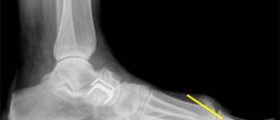What is the Talus?
The ankle joint is very complex, and the talus — also sometimes referred to as the ankle bone — is its most important bone.
Your leg and your foot are connected by the talus. You know how your feet can move in so many directions? This is because the talus and the joint that surround the talus (the ankle joint) allow for great mobility. The talus is directly responsible for the upward and downward movement in the ankle joint.
As it joins the heel bone (the calcaneus) to form the subtalar joint, the talus is also responsible for inward and outward movement of the foot. In this way, most of your foot and ankle related motions depend on the talus.
It won't come as a surprise that any injury to the talus or ankle bone will affect your mobility to a lesser or greater extent.

Injuries to the talus can be minor. For example, chips and small fragments may break off from the edge of the talus. There are also major talus-related fractures that can be debilitating, as these effect the multiple planes of movement of the foot and ankle. Fractures of the talus are most likely to occur during high-impact accidents, like a vehicle accident or falling from a great height.
Treating Fractures of the Ankle Bone
All talus fracture treatments aim to allow for maximization of the movement of the ankle and subtalar joints. Also, the goal is to restore the normal size and shape of the bone and to prevent occurrence of arthritis in both ankle and the subtalar joint later in life.
Planning the right treatment for a broken ankle bone can be complicated in cases of serious fractures due to their magnitude. Common complications with serious injuries include the development of arthritis or loss of blood supply to the bone. These complications can be serious, as the bone needs constant and uninterrupted blood supply in order to function properly, or in this case, to heal and regenerate after a fracture. Lack of blood supply commonly leads to arthritis or collapse of a part of the bone. A limp and chronic pain are among the complications of a talus fracture as well.
Treatment Options for a Broken Ankle Bone
Talus fractures can be treated using numerous different approaches. These approaches to treatment include immobilization (making sure you can't move the bone as it heals), as by placing the foot in a cast or a boot, or surgery. Surgery, if performed, uses incisions to approach the bone which is then reduced and put back together by means of pins and screws.
- Post-traumatic Arthritis
- Avascular Necrosis
- Infection
- Malunion and Nonunion
Recovery After a Broken Talus
The talus heals slowly. It takes two to three months before the patient is allowed to walk and put weight on the talus again, after the fracture. Once the talus bone heals, the function of the ankle should be boosted through exercise and physical therapy. If there is loss of blood flow to the talus and avascular necrosis (dying out of the bone due to lack of blood supply) occurs, it is common to attempt surgery aimed at improvement of blood circulation to the bone.

















Your thoughts on this
Loading...